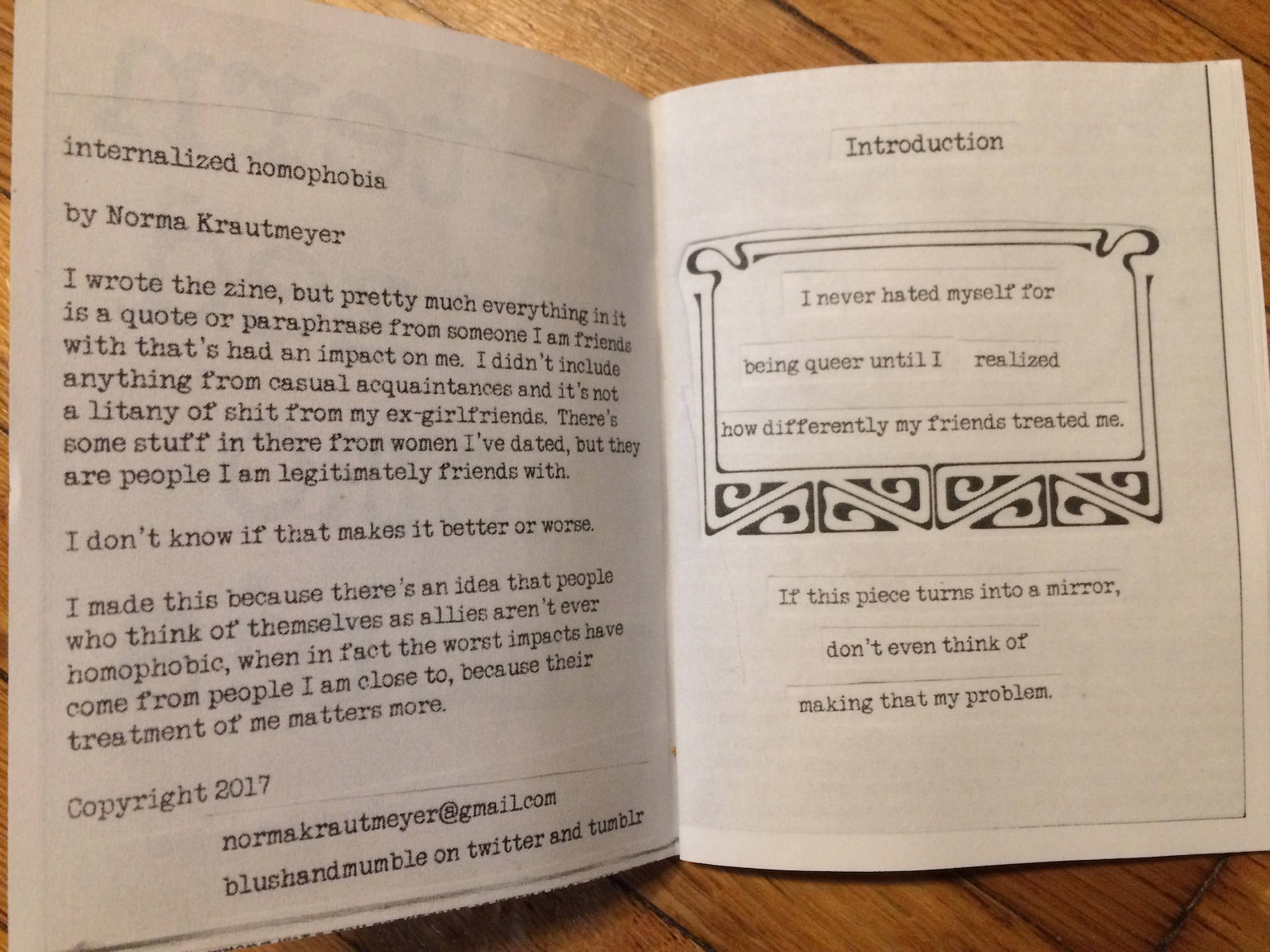Feeling a disconnect between who you are inside and how you present yourself to the world can be a really tough experience, can't it? For many in the LGBTQ+ community, this feeling often stems from something called internalized homophobia. It is a quiet, sometimes hidden struggle, yet it can cast a long shadow over one's life, affecting self-worth and genuine happiness.
This kind of struggle is very real, and it touches many people. When you internalize something, it's like you take in ideas, opinions, or beliefs from outside yourself, and they become a part of your own thinking, almost without you realizing it. So, too it's almost, negative messages about being gay or lesbian can get absorbed and turn into self-criticism, which is a bit painful.
Luckily, there are tools and resources out there to help unwind these deep-seated feelings. One really important resource is The Internalized Homophobia Workbook by Richard Isay. This workbook offers a gentle yet powerful way to explore these feelings and, in some respects, begin a path toward greater self-acceptance and inner peace.
Table of Contents
- About Richard Isay: A Pioneer in LGBTQ+ Mental Health
- What Is Internalized Homophobia? Getting a Clearer Picture
- Why Richard Isay's Workbook Matters for Your Healing
- Key Concepts and Exercises You Might Find
- How The Workbook Helps You Grow
- Who Can Benefit from This Workbook?
- Frequently Asked Questions About Internalized Homophobia
- Moving Forward with Self-Acceptance
About Richard Isay: A Pioneer in LGBTQ+ Mental Health
Richard A. Isay was, in fact, a very important figure in the field of psychiatry and a true advocate for gay and lesbian people. He challenged many old, hurtful ideas within his profession about homosexuality. His work helped pave the way for more accepting and helpful approaches to mental health care for the LGBTQ+ community, which is pretty significant.
He was a brave voice, really, speaking up when it was not always easy. His contributions helped change how many medical and psychological groups thought about sexual orientation, moving away from paths that caused harm and toward support. You know, he really made a difference.
Personal Details and Bio Data
Here's a brief look at some details about Richard Isay:
| Category | Details |
|---|---|
| Full Name | Richard A. Isay |
| Profession | Psychiatrist, Psychoanalyst, Author |
| Key Contributions | Pioneering work in gay affirmative therapy; challenged pathologizing views of homosexuality within psychiatry. |
| Notable Works | Authored books and articles on gay identity and mental health, including "Being Homosexual: Gay Men and Their Development." |
| Impact | Helped shift professional attitudes toward homosexuality from a disorder to a normal variation of human experience. |
What Is Internalized Homophobia? Getting a Clearer Picture
So, what exactly are we talking about when we say "internalized homophobia"? It's a rather complex idea, but it can be broken down. My text helps explain that internalizing something means you give a subjective character to it, or you incorporate values and patterns of culture within yourself, either consciously or subconsciously. It becomes a part of your character, you know?
This means, basically, that if you grow up in a world where negative ideas about being gay or lesbian are common, you might, in a way, absorb those ideas yourself. Even if you are gay or lesbian, you might start to believe some of those negative things about yourself or about other LGBTQ+ people. It's like taking in external experiences, emotions, or information and making them an integral part of your own beliefs, as my text puts it.
Think of it this way: if you feel anger or hurt but never show it, you internalize it—you keep it inside, as my text mentions. Similarly, with internalized homophobia, you might take in societal prejudices and turn them into self-criticism, self-doubt, or even a dislike of your own sexual orientation. Over time, as my text points out, she internalized her parents' attitudes; similarly, someone might internalize cultural values that are harmful.
This can show up in many ways. Maybe you find yourself judging other gay people harshly, or you feel a deep shame about your own attractions. Perhaps you try to hide your true self from others, or you might even struggle with accepting your own identity. It's a psychological process, really, where individuals subconsciously adopt attitudes, values, norms, and ideas prevalent in their environment, especially those that are negative about being LGBTQ+.
Why Richard Isay's Workbook Matters for Your Healing
Richard Isay's work, including the internalized homophobia workbook by richard isay, is important because it offers a structured way to confront these hidden feelings. For a long time, there weren't many resources that directly addressed this specific issue in a helpful, supportive way. His approach helps people understand that these feelings are not their fault, but rather a result of societal pressures, which is a big relief for many.
The workbook gives you a private space to explore thoughts and emotions that might be difficult to talk about with others. It's a tool for self-discovery, allowing you to gently unpack years of messages you might have absorbed. You know, it's like having a kind guide walking alongside you as you sort through things.
It helps you recognize how those external, negative ideas have become part of your inner world. Once you can see them clearly, you can start to challenge them. This workbook is, in fact, a practical guide for taking those first, brave steps toward feeling more comfortable and authentic in your own skin. It's about moving from hiding parts of yourself to truly embracing who you are.
Key Concepts and Exercises You Might Find
While I cannot share the exact contents of the internalized homophobia workbook by richard isay, most workbooks like this one typically focus on a few key ideas and involve certain types of activities. They are designed to help you process feelings and change old patterns of thinking. So, you can expect to engage in some deep self-reflection.
One common concept is identifying the source of negative beliefs. Where did these ideas about being gay or lesbian come from? Was it family, friends, media, or perhaps religious teachings? Understanding the origin can help you see that these are external ideas, not inherent flaws in you. It's about recognizing that these thoughts were, in some respects, put upon you.
Exercises often include journaling prompts. You might be asked to write about your experiences, your fears, or your hopes. This helps you express feelings that you might have kept inside for a long time. There might also be activities that encourage you to challenge negative self-talk, replacing it with more compassionate and realistic thoughts, which is pretty helpful.
Another important aspect is building self-compassion. The workbook probably encourages you to treat yourself with kindness and understanding, especially when you're dealing with difficult emotions. It's about learning to be your own friend, you know? This includes accepting your identity fully and celebrating who you are, rather than trying to change it.
Some sections might focus on setting boundaries with people or situations that trigger feelings of shame or discomfort. This is about protecting your mental well-being and creating a supportive environment for yourself. You might also find exercises related to building a strong support system of affirming friends and family.
How The Workbook Helps You Grow
Using the internalized homophobia workbook by richard isay can bring about several positive changes in your life. First, it helps you develop a greater awareness of your own thoughts and feelings. Many people don't even realize they have internalized homophobia until they start exploring it, so this awareness is a vital first step.
Secondly, it provides practical strategies for managing those negative thoughts and emotions. Instead of letting them control you, you learn how to observe them, question them, and eventually let them go. This is a very empowering process, really, because it gives you back control over your inner world.
The workbook can also help you build self-acceptance. As you work through the exercises, you'll likely start to feel more comfortable with your sexual orientation. This can lead to a deeper sense of authenticity and a stronger connection with your true self. It's about shedding the layers of what society told you to be and embracing who you actually are.
Moreover, it can improve your relationships with others. When you are more at peace with yourself, you can show up more genuinely in your friendships, family connections, and romantic partnerships. This can lead to more fulfilling and honest interactions. You know, it makes a big difference in how you connect with people.
Ultimately, the workbook aims to help you live a more joyful and integrated life. It's about moving past the pain of internalized stigma and stepping into a place of confidence and pride. This kind of work is, in some respects, an ongoing journey, but the workbook gives you a solid foundation to start from.
Who Can Benefit from This Workbook?
The internalized homophobia workbook by richard isay is primarily designed for gay and lesbian individuals who suspect they might be struggling with internalized negative feelings about their sexual orientation. If you find yourself experiencing self-doubt, shame, or a lack of self-worth related to being LGBTQ+, this workbook could be a helpful resource. It's for anyone who feels that societal messages have, in a way, seeped into their own self-perception.
It can also be very useful for those who are early in their coming out process, or who are still exploring their identity. The workbook offers a safe and private way to process feelings that might arise during this significant time. You know, it's a supportive companion for that journey.
Even individuals who have been out for a long time might find value in revisiting these topics. Internalized homophobia can linger, showing up in subtle ways even years later. This workbook provides an opportunity for deeper healing and a renewed sense of self-acceptance. It's basically a tool for continuous growth.
While it's a self-help tool, it can also be a wonderful supplement to therapy. Many therapists recommend workbooks like this to their clients as a way to continue the work outside of sessions. It provides structured exercises that can reinforce what is being discussed in therapy, which is pretty useful.
Finally, allies and mental health professionals who want to better understand the experiences of LGBTQ+ individuals might also find the concepts within the workbook insightful. It offers a window into the psychological processes that many queer people go through, helping others to be more supportive and effective in their roles. Learn more about self-acceptance and identity on our site, and link to this page for more resources on LGBTQ+ well-being.
Frequently Asked Questions About Internalized Homophobia
What causes internalized homophobia?
Internalized homophobia, in a way, comes from growing up in societies that often send negative messages about being gay or lesbian. These messages can come from family, friends, schools, religious institutions, or the media. Over time, a person might absorb these ideas, even if they are gay themselves, and they become part of their own beliefs about themselves. It's a rather common experience for many.
How can I stop internalizing homophobia?
Stopping internalized homophobia involves several steps. First, it's about becoming aware of those negative thoughts and beliefs. Then, you can challenge them, questioning their validity and replacing them with more positive, affirming thoughts. Seeking support from trusted friends, family, or a therapist can also be very helpful. Tools like the internalized homophobia workbook by richard isay provide structured ways to do this work, giving you practical exercises to move forward.
Is internalized homophobia a mental illness?
No, internalized homophobia is not a mental illness. It's a psychological process where someone absorbs societal prejudices and turns them inward. However, it can certainly contribute to mental health challenges like anxiety, depression, low self-esteem, or substance use, which is important to recognize. Addressing internalized homophobia is a key part of supporting overall mental well-being for LGBTQ+ individuals.
Moving Forward with Self-Acceptance
Taking steps to address internalized homophobia is a powerful act of self-love. It's about reclaiming your true self from the weight of societal expectations and prejudices. The internalized homophobia workbook by richard isay stands as a testament to the idea that healing is possible, and that living authentically is within reach for everyone.
If you've been feeling the effects of these hidden struggles, consider exploring this workbook. It offers a structured, thoughtful way to unpack those feelings and begin building a stronger, more accepting relationship with yourself. You know, it's a really good way to start feeling better today. Remember, you deserve to live a life filled with pride and genuine self-acceptance, and there are tools out there to help you get there.



Detail Author:
- Name : Enola Marquardt
- Username : mozell84
- Email : weber.aliza@hotmail.com
- Birthdate : 1988-08-08
- Address : 21475 Donnelly Garden Jonathonmouth, IL 95842-3425
- Phone : +1-234-397-5538
- Company : Toy-Schuster
- Job : Floor Layer
- Bio : Suscipit delectus voluptas commodi praesentium. Mollitia occaecati dolorem nam nesciunt qui voluptas. Exercitationem ut qui aspernatur. Sunt ex corrupti iste qui facere itaque ut quia.
Socials
instagram:
- url : https://instagram.com/frunolfsson
- username : frunolfsson
- bio : Non recusandae eveniet et deleniti. Atque animi tenetur quo ut. Voluptate ex minus et quis ea.
- followers : 6420
- following : 194
facebook:
- url : https://facebook.com/fred792
- username : fred792
- bio : Id eaque placeat porro omnis deleniti dolor animi.
- followers : 690
- following : 1199

